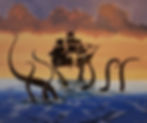The Kraken: truth behind the mythos
- SATNAVmagazine
- Mar 1, 2019
- 3 min read
Updated: Aug 10, 2020
Dive into the deep sea world on a quest to unveil the Kraken
By Harry Holmes
For thousands of years, tales have been told of the fearsome oceanic creatures of the depths, from ancient sea serpents to the Loch Ness monster. It is no wonder that such legends evolved; the oceans are famously inhospitable to humans and, until 1919, we had no idea just how deep they can be.

Over the last century, we have come to learn much about the deep ocean. Primarily, that life there thrives to a considerably greater extent than was expected. The oceans are home to the vast majority of life on Earth, but remain as mysterious to us as Outer Space. It is estimated that 91% of oceanic life has yet to be discovered and classified.
The deep sea can be categorised into several layers, colloquially referred to as the Twilight, Midnight, Abyssal and Hadal zones, reflecting the concentration of light able to permeate. Remarkably, despite incredible hydrostatic pressure and the absence of sunlight, life thrives within the Hadal zone, named after Hades, the Ancient Greek God of the Underworld.
Since the 12th Century, Scandinavian fishermen have told tales of the Kraken, a tentacled creature over a mile long that would emerge from the deep sea to pull sailors from ships, dragging them into the unfathomable depths of the ocean. The Kraken was widely assumed to be a myth, until 1857, when a large squid beak was examined by Danish zoologist, Japetus Steenstrup. With this beak and the discovery of other specimens from the Bahamas, he determined that they belonged to a new species of giant squid, which he named Architeuthis dux, or “Ruling Squid”. This squid may have inspired the fables of the Kraken.
Though their existence has been established for over 150 years, very little is known about giant squid and the mysterious deep ocean world they inhabit. They are estimated to grow up to thirteen metres in length, rivalling Scandinavian fisherman boats. As well as a sharp beak, the squid have eight arms with suction cups lined with razor-like spines, and two long tentacles. Should an unfortunate sailor ever get caught in these, they would never escape.
Similarly nightmare-inducing and mysterious, colossal squid (Mesonychoteuthis hamiltoni), are theorised to grow up to twelve metres in length and possess arms lined with hooked suction cups, and tentacles with rotating hooks, allowing them to rip into the flesh of prey and predators. Although shorter in length, the larger body of the colossal squid is more similar to the Kraken than the giant squid.
Reflecting the dangers of the submerged world in which they live, the giant squid and the colossal squid share the title for world’s largest eye, at 27 centimetres in diameter. These are thought to help them evade predation by sperm whales, which dive down into the Twilight Zone to hunt the elusive squid. Despite these Kraken-like features, both giant and colossal squid appear to be passive, scavenging and preying on fish that stray too close, as opposed to the aggressive monsters depicted in folklore. Perhaps one of these squid was spotted centuries ago and the story was embellished, or perhaps we have yet to discover the true Kraken.
The deep sea is expansive, and holds many secrets. Not only could these squid species grow to be larger than we currently estimate, but it would not be absurd to suggest that there is a true Kraken, living deep in the dark underworld of the Hadal zone. Until we explore further, we will never know.
From Issue 17
For more information, see:
_edited_edited.jpg)


